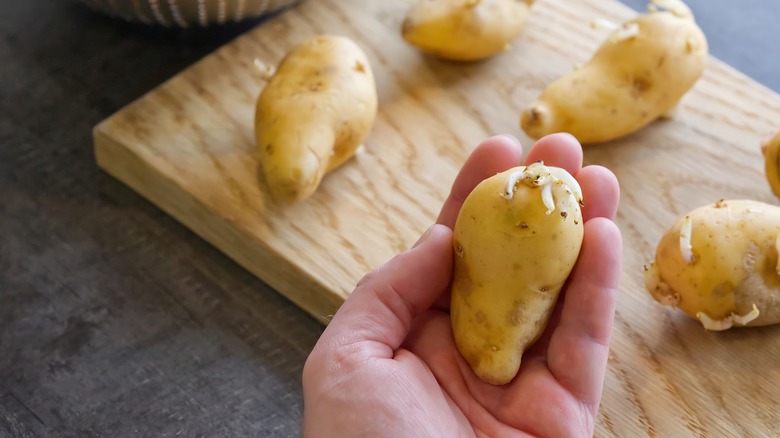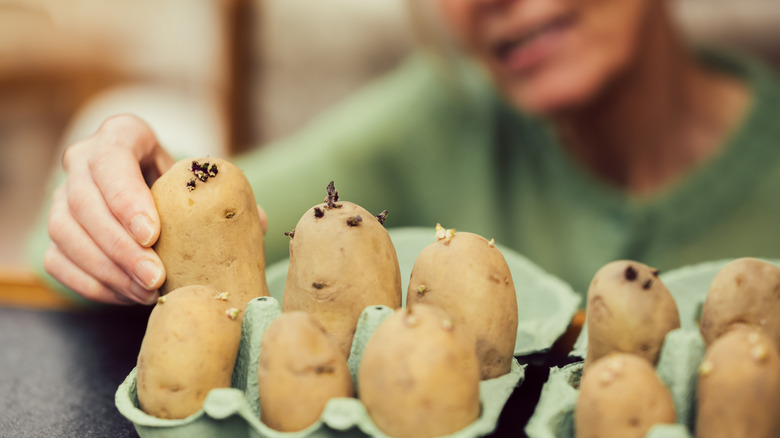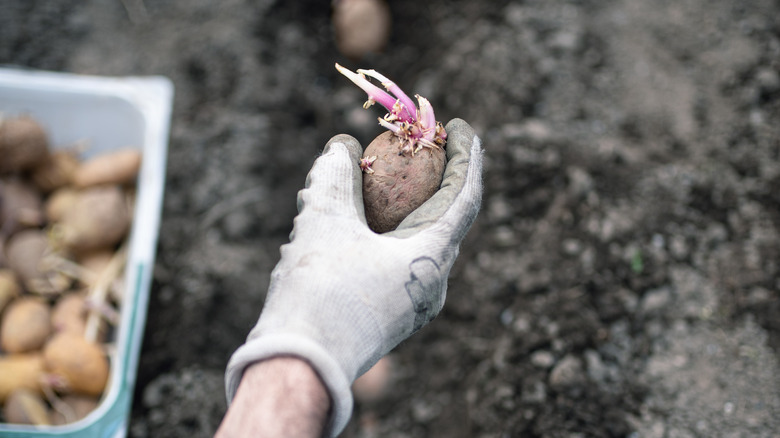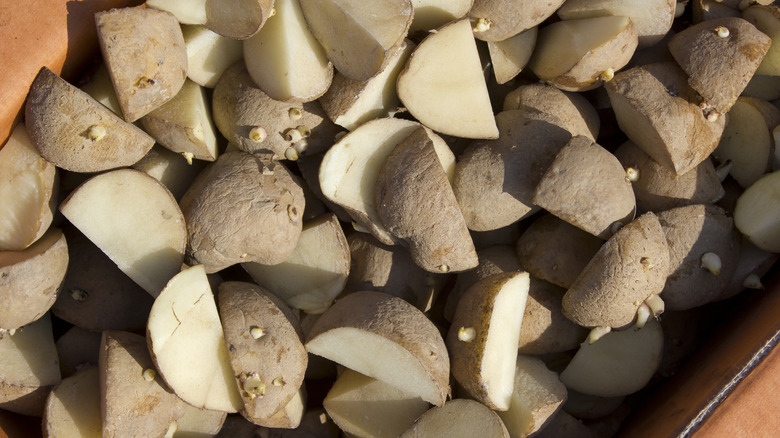Does Chitting Your Potatoes Before Planting Lead To A Bigger Harvest? Our Master Gardener Weighs In
Sometimes chitting potatoes happens by accident. If you have ever had potatoes sprout in your cupboard before you can eat them, that's essentially the process. Chitting potatoes is the practice of allowing seed potatoes to sprout indoors before transplanting them to get a head start on your planting. It is not difficult to do, but you have to get the timing and preparation right to potentially get a bigger harvest.
Although you can plant sprouted potatoes from the grocery store, you'll want to buy seed potatoes for the largest harvest. Potatoes are grown around the world, so unless you know they are locally grown, those available in the produce department are probably not ideal for your specific region. Some varieties like cooler temperatures while others will not mature until it gets hot. Purchasing seed potatoes appropriate for your region will ensure you get the biggest reward for your hard work. Still, if you have some sprouted taters in the kitchen and a little extra space to plant, it's fun to experiment.
Chitting potatoes
Egg cartons are ideal for holding potatoes while they grow stems. Seed potatoes are smaller than those you find at the supermarket, so each one should fit snugly in a space about the size of an egg. This will keep the stems growing vertically and keep your potatoes from rolling around, damaging new growth.
To grow chitted potatoes, simply cut the solid top off an egg carton and place your seed potatoes in the indentions with one or two eyes pointing up. The eyes are tiny indentions in the tuber where the stems will grow. Since chitting is the process of sprouting potatoes, you want those pointed toward the light. Chitting takes a few months, so you'll need to start chitting your potatoes indoors in January or February, depending on where you live. This can create a challenge because sometimes seed potatoes are not available locally until later in the spring. You may need to order potatoes online to have time to sprout them before it's time to plant.
It may seem like a bright, warm window is the ideal place to start the chitting process, but as the saying goes, you'll need to "begin the way you mean to go on." Potatoes naturally sprout in cool, dark soil. The space you prepare them should be a similar temperature to the soil when you plant, so a basement, garage, or unheated shed that stays above freezing will properly prepare your potatoes for planting.
How to plant sprouted potatoes
Once your chitted potatoes have sprouts that are about an inch long, they are ready to be planted. You can wait a bit longer if the soil conditions are not ideal, but try not to wait until the sprouts are more than a few inches. This will make them more susceptible to breaking off and they may not adjust to transplanting as well as smaller sprouts. If you are planting your potatoes in the ground, dig a trench about 6 inches deep and place your chitted potatoes about 16 inches apart. This spacing will allow plenty of room for each plant to produce many full-sized potatoes for an abundant harvest. When planting, make sure the sprouted eyes are pointed up and gently cover them with loosened soil. Do not push down on the soil with your foot or a garden tool to avoid breaking off the delicate sprouts.
Water your chitted potatoes well after planting, or if possible, plant them just before it rains. Chitted potato sprouts will emerge above the ground more quickly than standard seed potatoes, so keep an eye out for those delicate sprouts. Once they are about 4 inches tall, you'll need to start mounding soil up around the greens, up to the top leaves. This encourages the plant to grow more roots, which will produce more potatoes. Repeat this process when the stems have grown another 8 inches, then leave your plants alone to produce tubers.
Cutting chitted potatoes for maximum harvest
As you ponder the question, "to chit or not to chit," there are two main considerations. The primary benefit is getting to harvest your potatoes earlier. Chitting itself does not guarantee a bigger harvest, although it does give you a little more time for tubers to grow in areas that experience a hot summer. To get the most out of your chitted potatoes, you can divide them and plant each sprouted eye separately, giving you more plants and therefore, a larger harvest.
While you can plant seed potatoes whole, most people cut them into separate pieces with one or two eyes. To prevent rotting, the cut parts of the tubers need time to scab over. Unsprouted seed potatoes can be cut up to 4 weeks before planting, but once they have sprouted, the growing process has already begun. Slicing them too far in advance could cause them to rot before they are in the ground, so if you are dividing chit potatoes, wait until 2 weeks before planting to cut them.



